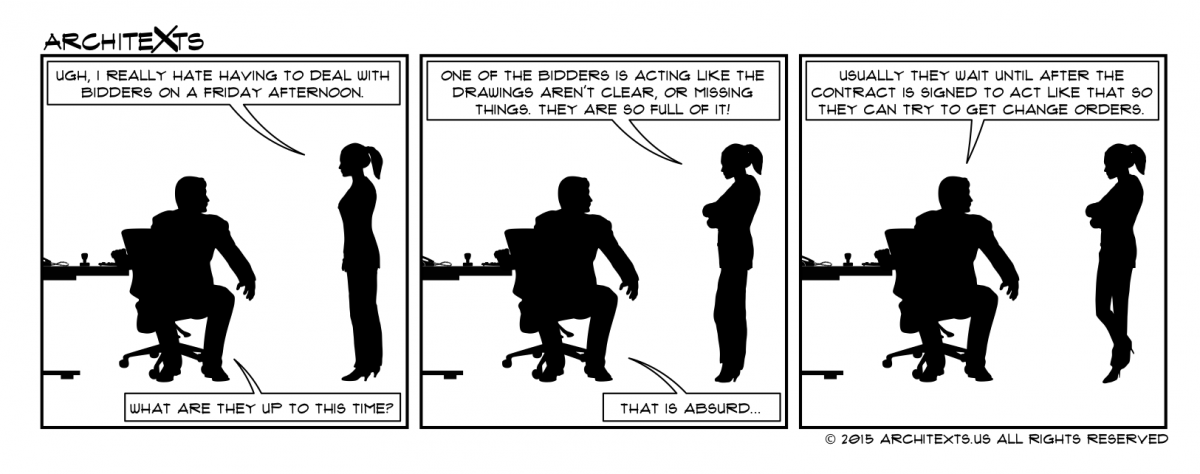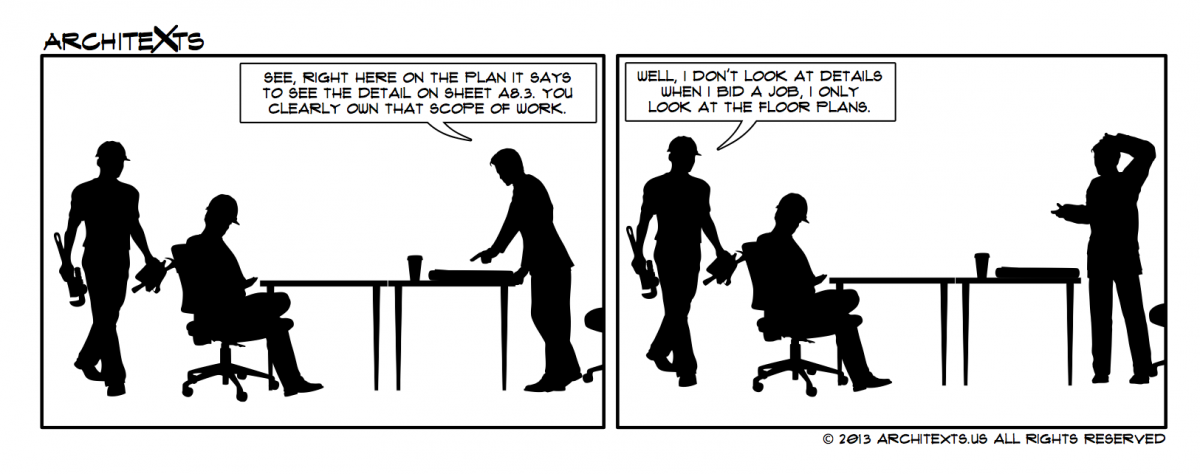1. BID PROCESS
Developing your Bid Package is the most important part of this process. Clearly communicating the project details, scope of work, qualification requirements of bidders, and contracting requirements is the goal of the Bid Package.
A sample can be found in the PDF below.
The Invitation to Bid is a request for pricing. It precedes the bid documents and describes the following:
- Type and size of project
- Location of project
- Project start date and completion schedule
- Bonding requirements
- Legal requirements (procedures for DQ, etc.)
- Pre-bid conference requirements
- Document retrieval instructions, contact information
- BID DUE DATE
This document is usually short and may take the form of a letter or memo.
The Instructions to Bidders are often bound with the specifications or bid documents. They may repeat information from the Invitation to Bid, but are generally a longer, more detailed document, including the following:
- BID DUE DATE
- Bid delivery location
- Bid Form
- Instructions for completing the Bid Form
- Instructions, policies on alternates and unit pricing
- Insurance and bonding requirements
- Explanation of bid award procedures
- Expected dates of award or start of project
2. BID ANALYSIS
The Bid Form is distributed with the bid documents to standardize bids received and make them more comparable.
May include the following:
- Name of contractor and company information
- Price, written in numbers and words
- Price breakdown for major trades or pieces of work
- Alternates, if allowed
- Unit prices, if required
- Bond information
- Project schedule
- Acknowledgement of receipt of all bid documents, addenda, etc.
- Signature, title, and date
Bid leveling is the process of reviewing bids for completeness and in comparison to one another.
Don’t be this contractor:
3. AWARD PROCESS
The bid process ends when the project owner selects a winner (or winners) and awards a contract.
Contracts exist to protect you when something goes wrong on a project. The worst contract in the world won’t make a difference if everything goes smoothly. It’s possible that no one will look at the contract ever again.
Contracts between different parties on the project may include the following:
- Agreement
- General Conditions
- Special Conditions
- Insurance requirements
- Sample insurance form
- Bond information
Agreements should include the following:
- Identification of the parties
- Description of the scope of work
- List of contract documents covered (dwgs, specs, addenda, alternates, etc.)
- CONTRACT SUM
- Start date
- Date of substantial completion
- Liquidated damages (a clause covering damages due to late completion)
- Payment schedule and terms, if any
- Retainage schedule
- Terms of final payment
4. INSURANCE AND BONDING
Insurance protects against risks associated with the project. Commonly includes the following areas:
- Property: Builder’s risk: covers damages to the building while it is under the contractor’s control
- Liability: Comprehensive liability: covers damages awarded to an injured party in a lawsuit resulting from injury to property or person caused by a contractor’s (in)actions. Errors and omissions liability: covers design consultants professional advice from civil suits
- People: Worker’s Compensation: covers disability and medical treatment for injuries resulting from accidents occurring during work
Insurance requirements must be made clear prior to bidding.
Bonds (or surety bonds) protect the owner in case of failure to perform by the contractor. Typical bonds cover the following:
- Bid Bond
- Performance Bond
- Payment Bond
Check out Construction Bonds for Dummies from the Construction Industry Podcast.
Not an insurance policy, a surety bond is a guarantee, in which the surety guarantees that the contractor, called the principal in the bond, will perform the obligation stated in the bond.
The person or firm to whom the principal and surety owe their obligation is called the obligee. On bid bonds, performance bonds, and payment bonds, the obligee is usually the owner. Where a subcontractor furnishes a bond, however, the obligee may be the owner or the general contractor or both.
The people or firms who are entitled to sue on a bond are sometimes called beneficiaries of the bond.
The obligation stated in a bid bond is that the principal will honor its bid.
The obligation in a performance bond is that the principal will complete the project.
The obligation in a payment bond is that the principal will properly pay subcontractors and suppliers.
A common condition of the bond is that if the principal fully performs the stated obligation, then the bond is void. Via attny
Because bonds require a down payment and therefore are a cost to the contractor, projects that require bonding must state that prior to bidding (or the cost of bonding will be an additive change order to the project).





